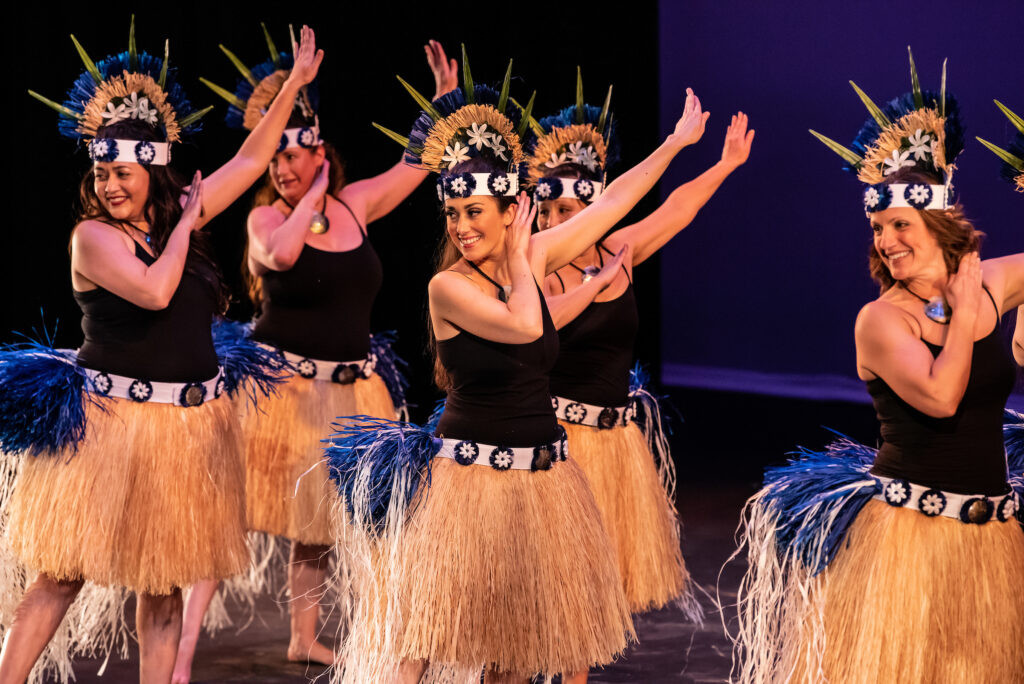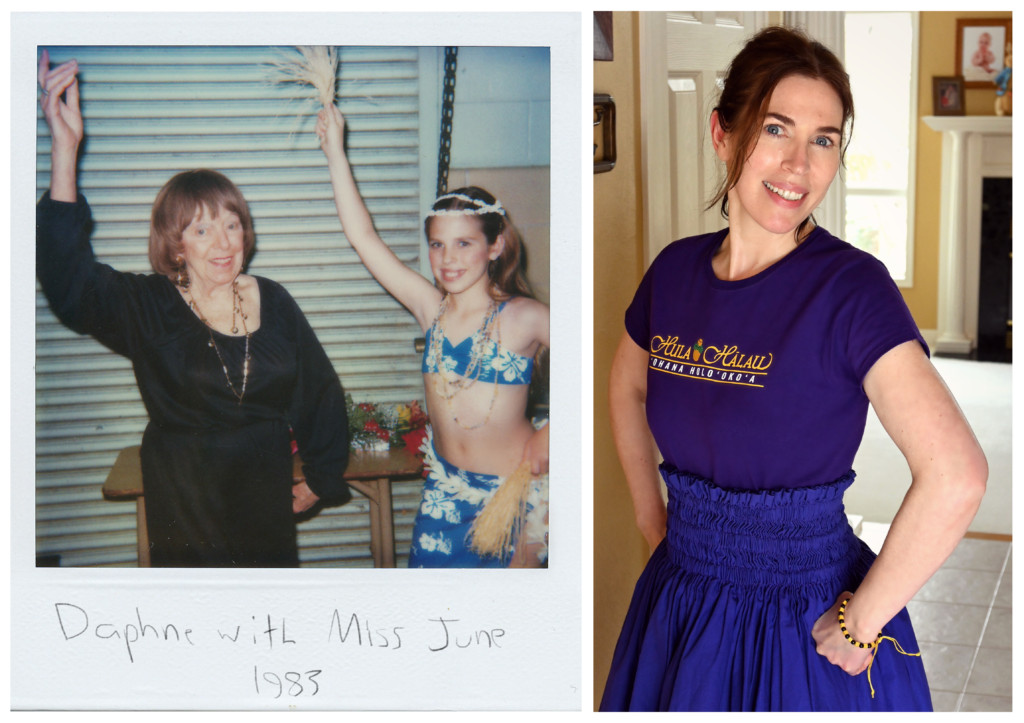Lisa Chang describes learning hula as a layered journey into the heart of Hawaiian culture. Hula is a dance with endless depth, welcoming beginners at any age. “The elegant movements, the joy of staying active, the deep social connections, and sharing the aloha spirit have been profoundly healing,” Lisa explains, reflecting on her hula experience.
Growing up as a third-generation Japanese American in Portland, Oregon, during the 60s and 70s, Lisa (pictured top right in the above photo) often felt like an outsider. This sense of belonging began to shift in college when she befriended students from Hawai’i. They encouraged her to join the school’s Hawaiian Club, where she discovered a welcoming community and soon found herself learning Hawaiian Hula Dance for her first Lu’au. After college, while working as a pharmacist in the California Bay Area, she found another hula family at Hula Halau ‘O Pi‘ilani, under the guidance of Kumu Hula Linda Pi‘ilani Danek, whom Lisa affectionately calls “Auntie Linda.” Lisa’s dedication allowed her to advance quickly, assisting with teaching, dancing competitively, and earning recognition.
Upon returning to Portland in the mid-90s, where she raised her two children with her husband from O‘ahu, Lisa received numerous requests to teach hula. With Auntie Linda’s blessing, Lisa established her own school, Hula Hālau ‘Ohana Holo‘oko‘a, meaning “School Of Hula Where Everyone Is Family.” Lisa teaches both Hula Kahiko (ancient hula), accompanied by chants and traditional instruments, and Hula ‘Auana (modern hula), which narrates stories through graceful limb and hip movements, typically set to song and Western-influenced stringed instruments. She also teaches Tahitian dance, a style related to hula but characterized by closer footwork and faster-paced, rapid hip movements driven by drumbeats.
Finding Family and Connection Through Hula
Over the years, Lisa’s classes expanded from her home to a studio and now, reaching even further through Zoom, allowing her to share the rich Hawaiian culture of dance, community, music, and language with students of all ages and backgrounds. I initially met Lisa via Zoom for a private lesson. Her presence is striking, not just because of her physical beauty, but because of her inherent grace and purposeful demeanor. Remarkably, she celebrated her 60th birthday last fall. Lately, I’ve found myself increasingly curious about individuals navigating life beyond midlife, much like my fascination with young adults when I was on the cusp of adolescence. However, this time, it’s not about imitation driven by insecurity. I am genuinely interested in connecting with real people pursuing diverse and challenging paths. Observing the spectrum of experiences in others’ lives broadens my own sense of possibility.
I was quickly reminded of hula’s unique challenge and depth. It’s an incredibly nuanced, complex, and holistic movement form. I engaged muscles I had long forgotten and was surprised by how such subtle motions could elevate my heart rate.
As Lisa gracefully demonstrated the basic Hawaiian hula dance movements, I followed along, drawing on memories from lessons decades prior. I was quickly reminded of hula’s unique challenge and depth. It’s an incredibly nuanced, complex, and holistic movement form. I engaged muscles I had long forgotten and was surprised by how such subtle motions could elevate my heart rate. Focusing on posture, foot placement, and basic hip movements alone offered immediate rewards. I was eager to delve deeper.
Embracing Wholeness in Midlife Through Movement

In my 40s, I’ve been reflecting on how I’ve moved my body throughout my life and how I desire to move now. My old comfort zone no longer feels comfortable, perhaps it never truly did. I need to explore different ways of moving, to discover a new sense of ease. My past comfort zone was often about projecting an image of health and virtue, moving to meet external expectations and social validation. While some of it was enjoyable, there was always an underlying pressure to conform, even when my heart wasn’t in it. My movement was not for myself, but to fit in, to fulfill a role, or to seek approval.
For example, as a cheerleader in my teens, I chanted and performed sharp, defined movements with my limbs. In poms, I executed high kicks in synchronized lines. Later, I moved to the rhythms of hard rock and grunge concerts. In Women’s Workout World health clubs, I stepped onto aerobic platforms with purple risers alongside baby boomers in business suits and Reeboks. I followed J.Lo’s evolution from her In Living Color Fly Girl days to her sultry Jenny From the Block persona, dancing for an audience of one – myself in the mirror.
In 5 a.m. fitness classes, I spun, kickboxed, and pushed through H.I.I.T. workouts with other dedicated, slightly masochistic individuals. During my baby-wearing years, I swayed endlessly, soothing both my child and myself. I chased toddlers while running errands. I pushed strollers, vacuums, and overflowing shopping carts. Then, sometime after 40, after years of pushing my physical limits, I began to slow down – because I wanted to, because I needed to, and because I was tired and questioning the purpose.
Now, in midlife, I seek wholeness. I want to integrate all the pieces of my past self into who I am now, irrespective of social context. Equally important, I want to create space for the future, acknowledging that it will include both desired and undesired experiences: illness, grief, loss, uncertainty. By making space for these realities now, I can lessen my anxiety about what lies ahead. This reflection draws me back to Saturday mornings in the 80s when I first encountered Hawaiian hula dance.
Echoes of the Leg-Warmer ‘80s and Early Dance Roots
As a child, Saturday mornings were often spent cross-legged on avocado green carpeting, immersed in cartoons on the floor model TV. My brothers and I would gather around, making trips to the kitchen during commercials to refill bowls of cereal, milk, and sugar, accepting the less exciting Wheaties, Rice Krispies, or Corn Flakes, while yearning for the sugary brands advertised on screen.
However, those cartoon-filled Saturdays were limited to summers or school breaks. Most Saturdays were dedicated to June Rold School of Dance in Des Plaines, Illinois, where some of my most cherished childhood memories reside. Standing in my chalk-drawn circle, anticipation grew with each rhythmic scratch of the record player. Repeatedly, I’d wait for the music to begin, for another opportunity at perfection, or at least progress. With each beat, I sensed infinite possibilities reflected in the dance studio’s infinity mirror. My reflection felt like validation of my existence.
The comforting pink leotard and tights, soft ballet slippers, and shiny black tap shoes made me feel seen, unlike my everyday clothes – 70s hand-me-downs. Stiff, polyester, and scratchy, they had frayed seams and exposed elastic. In contrast, my dance clothes stretched perfectly, moving with me in every direction. This felt like freedom. Every aspiring dancer in the leg-warmer-clad 80s shared this feeling, inspired by stories like that of the exotic-dancing welder turned professional ballet dancer, proving anything was possible. Although I wouldn’t see the movie for a few years, Irene Cara’s “Flashdance… What a Feeling” became an anthem, motivating us to “Take your passion / And make it happen.”
In the same white brick building near the Metra train tracks, traditional dance classes were offered for the Pacific Islander Chicago community to preserve their culture and cultivate talent for a touring dance troupe. Miss June opened these classes to all her students, and I, along with students from diverse backgrounds, was welcomed to learn their traditional dances, honored to participate in their rich heritage.

I discovered Hawaiian hula dance to be surprisingly complex. I felt my entire body engaged: fluid hips guided by the feet, arms, wrists, and hands telling a story, complemented by facial expressions and head tilts. It required focused concentration to integrate everything. With feeling, structure, and purpose, I learned to move continuously through the rhythm of each beat. While called “dance,” it was a more intricate art form, often incorporating musical instruments. Each dance was a narrative, a piece of history. Decades later, I am deeply grateful for those early experiences.
For me, hula embodies a beautiful balance of comfort within discipline, allowing for both self-presence and connection through respectful acceptance. While our broader culture is gradually moving towards this inclusivity, back then, the idea that every body, every age, and every person deserved acceptance felt radical. As I learned to move my hips in swaying, circular, and figure-eight motions that felt inherently natural, I didn’t receive the same message outside of dance class.
Growing older, it seemed that only young, beautiful, exceptionally talented, thin, and famous individuals were granted permission to move their hips freely – and even then, judgment often followed. For ordinary people, natural hip movements often led to shame and self-consciousness. Watching Flashdance on VHS, the message was clear: even with incredible dance talent, natural hip movements were not respected. However, learning the “respectable” dance form of ballet, with its controlled hip movements, could elevate you to a “real dancer,” worthy of a condescending, older, high-society boyfriend.
Seeking wholeness in my 40-something body, I crave those symmetrical, gentle, fluid and focused body movements … And I believe hula movements will also support my older body through dynamic core work, and add flexibility in so many joints that tend to stiffen with age – hips, shoulders, hands and wrists.
Breaking Down Self-Imposed Barriers to Re-Engage
Now, seeking wholeness in my 40-something body, I long for those symmetrical, gentle, fluid, and focused body movements I learned years ago. I believe Hawaiian hula dance will support my aging body through dynamic core strengthening and improved flexibility in joints that tend to stiffen with age – hips, shoulders, hands, and wrists.
I recently joined Lisa’s online hula and Tahitian classes. While self-teaching through videos is an option, I knew I would miss crucial feedback and the sense of community, an integral part of hula. “We strongly encourage connecting with your hula sisters/family,” Lisa emphasizes. “It might sound repetitive, but my best advice for all women is to stay active (try hula!), eat healthily, and maintain social connections.”
As simple as it sounds, I understand why it can be challenging. I had considered returning to hula for years, but never took action until this story assignment. Having an assignment gave me permission to pursue this creative interest. But it raises the question: Didn’t I have a reason before? And whose permission was I waiting for?
I realize that some barriers are self-imposed. Perhaps these barriers served a purpose in my youth, preventing me from becoming too scattered. But midlife is different. In his book, The Power of Regret, Daniel Pink explains that in midlife, regrets of inaction outweigh regrets of action. Therefore, midlife is the perfect time to, indeed, “take your passion, and make it happen.”
For me, that passion and connection are rooted in the Hawaiian hula dance of my childhood. Re-engaging with it as an adult has been truly liberating, bringing comfort and a sense of belonging.
Not everyone danced hula as a child, but most of us have a childhood activity that brought comfort and connection. The question is, what’s your hula, and how can you incorporate it into your adult life to feel more whole?
